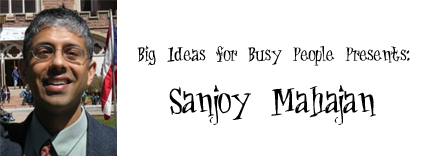
Sanjoy Mahajan is a ninja. He is not a ninja in the conventional sense of the word. He does not wear black garb and a face mask, nor does he make stealthy forays into castles. Instead, he dons intuition and reasoning to tackle problems. Mahajan’s specialty? Street-fighting mathematics and science.
Math is a battle for many people in the United States, in part because our math education is just not up to scratch. Mahajan, currently a visiting professor at Olin and the Associate Director of the MIT Teaching and Learning Laboratory, has this to say about American math education: “It’s a scandal. It’s an education disaster, and I want to do something about it. I’ll give you an example of how terrible it is. National Assessment of Educational Progress surveyed 50,000 students to estimate the answer to 3.04 times 5.3. The students were given four choices: 1.6, 16, 160, 1600. Thirteen-year-olds were pretty much random guessing. Seventeen-year-olds, only 37% of them actually picked 16.”
To Mahajan, that meant the students have no understanding of the number system at all. They can only do the route manipulation, and when thrown a curveball to estimate 3.04 times 5.3, they couldn’t do it.
Mahajan wants to change this. “I want to change how people thing about numbers, because people are just afraid. They were just so badly taught that they think math is about the one exact way to get the right answer… and they get afraid and paralyzed if they can’t remember every little detail.” Mahajan wants to give people the tools to “street-fight their way out of that paralysis.”
What makes an example of this kind of street-fighting? Take this problem as an example: How would you estimate how high an animal can jump?
Mahajan’s approach is to first assume that every animal has, by mass, the same fraction of muscle. Let’s say that this fraction is 40% (as it turns out, this is not far from the truth), and that all muscles store energy equally. Therefore, the energy an animal has is proportional to its mass. The next question is: how much energy does an animal need to jump to a particular height? Based on potential energy, this is proportional to the animal’s mass and jump height.
So the animal can supply energy proportional to its mass, and to jump, the animal must use energy proportional to its mass and proportional to its jump height. Mass appears on both the supply and the demand side, leaving only height to be the real affecting parameter. Therefore, by this reasoning, all animals can jump the same height. Indeed, it turns out that of mice and men, both can jump to the same height, which is about half a meter.
(This reasoning does break down for fleas, however, because their energy is a lot less than their surface area. As a result, fleas end up feeling too much drag, though in a vacuum, they could probably jump just as high.)
Problem-solving of this ilk emphasizes Mahajan’s style of teaching, learning, and, of course, problem-solving. Mahajan realized while studying for his physics grad school qualification exams that he had learned way more in three months than he did in four years of physics education. “I realized there was a lot of things that can be done to improve teaching and thinking and learning,” says Mahajan regarding that experience. “One way to do it is to teach people to think approximately, intuitively, qualitatively.... Don’t try to learn the useless details. Try to learn the broad structure that holds all the ideas together. That was the same way how I decided to teach things, by tools.”
By now, Mahajan has taught a number of courses with this philosophy, wowing students with his adroit problem-solving abilities and teaching prowess. No student of Mahajan’s forgets him or the lessons he teaches.
Mahajan is on a quest to spread street-fighting mathematics. He has already published a textbook called Street Fighting Mathematics: The Art of Educated Guessing and Opportunistic Problem Solving (you can purchase or download a pdf for free here), and he is currently working on a new general audience book called Numbersight: Street-Fighting Tools for Mastering the Numbers Around You (“Numbersight” is a play on the word “insight”).
Sanjoy Mahajan will be presenting at the Pre-Festival Event, Big Ideas for Busy People, where ten of Cambridge’s top thinkers will each be giving lightning-paced lectures of five minutes with an extra five minutes for questions.
What will Mahajan be talking about at this event? Street-fighting math and science, of course. And he’s going to answer this following problem: how can you use coffee filters to determine the gas mileage of a 747 airplane?
You’ll have to attend Big Ideas to find out.
Big Ideas for Busy People will take place on Friday, April 29 between 7:30-9:30 pm at the Laboratory at Harvard, Northwest Building, 52 Oxford Street.

No comments:
Post a Comment